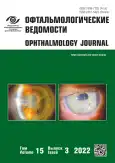Treatment approaches to postoperative fibrinoid syndrome after phacoemulsification
- Authors: Belov D.F.1, Petukhov V.P.1
-
Affiliations:
- Saint Petersburg Multifield Hospital No. 2
- Issue: Vol 15, No 3 (2022)
- Pages: 19-27
- Section: Original study articles
- URL: https://journals.rcsi.science/ov/article/view/131573
- DOI: https://doi.org/10.17816/OV109480
- ID: 131573
Cite item
Abstract
BACKGROUND: Postoperative fibrinoid syndrome (PFS) is an early complication of phacoemulsification, manifested by fibrin deposition on the iris and the intraocular lens surface, which leads to visual acuity decrease.
AIM: To assess the rate and the treatment efficacy (by YAG laser, enzymatic, medicalmentous) in PFS after phacoemulsification.
MATERIALS AND METHODS: Retrospective analysis of 56,019 cataract surgery cases of 2017–2021. There were 49 patients with PFS divided into 3 groups according to treatment approaches: 1st group — medicamentous treatment (MT) + YAG laser destruction of the fibrin film (n = 6); 2nd — MT + prourokinase injection into the anterior chamber (n = 6); 3rd — MT only (n = 37).
RESULTS: There was no difference between groups in best-corrected visual acuity (BCVA) before the PFS development. There was a more rapid increase in BCVA in the 1st and the 2nd groups compared with the 3rd one on the third day (0.20 ± 0.09 and 0.21 ± 0.08 versus 0.09 ± 0.08 for groups respectively, p = 0.001) and on the fifth day of treatment (0.25 ± 0.10 and 0.27 ± 0.13 versus 0.16 ± 0.14, p = 0.029). Nevertheless, in one week, there was no difference in BCVA between groups. Unfortunately, BCVA did not return to baseline in any group.
CONCLUSION: The incidence of PFS after phacoemulsification is relatively low and amounts to 0.093%. The most rapid BCVA recovery was observed in the 1st and the 2nd groups.
Full Text
##article.viewOnOriginalSite##About the authors
Dmitrii F. Belov
Saint Petersburg Multifield Hospital No. 2
Author for correspondence.
Email: belovd1990@gmail.com
ORCID iD: 0000-0003-0776-4065
SPIN-code: 2380-2273
MD, Cand. Sci. (Med.), Ophthalmologist
Russian Federation, Saint PetersburgVladimir P. Petukhov
Saint Petersburg Multifield Hospital No. 2
Email: v.p.petukhov@gmail.com
ORCID iD: 0000-0003-4973-3937
SPIN-code: 2879-9313
Ophthalmologist
Russian Federation, Saint PetersburgReferences
- Gndoyan IA. Use of the fibrinolytic drug trombovazim in the fibrinoid syndrome treatment after cataract extraction. Journal of Volgograd State Medical University. 2012;(2):28–32. (In Russ.)
- Boiko EhV, Danilichev VF, Kol’tsova SV. Ehksperimental’noe obosnovanie primeneniya rekombinantnoi prourokinazy i ee immobilizirovannykh form dlya lecheniya posleoperatsionnogo fibrinoidnogo sindroma v oftal’mologii. Byulleten’ eksperimental’noj biologii i mediciny. 1997;123(2):201–204. (In Russ.)
- Novoderezhkin VV. Lazernaya korrektsiya fibrinoidnogo sindroma v posleoperatsionnom periode posle ehkstraktsii katarakty. Russian Journal of Clinical Ophthalmology. 2001;(3):114. (In Russ.)
- Nishi O. Fibrinous membrane formation on the posterior chamber lens during the early postoperative period. J Cataract Refract Surg. 1988;14(1):73–77. doi: 10.1016/s0886-3350(88)80068-3
- Ficker L, Meredith TA, Wilson LA, et al. Chronic bacterial endophthalmitis. Am J Ophthalmol. 1987;103(6):745–748. doi: 10.1016/s0002-9394(14)74386-7
- Logai IM, Leus NF. Selektivnye ingibitory sinteza prostaglandinov. Oftal’mologicheskii zhurnal. 1999;(4):286–293. (In Russ.)
- Müller-Jensen K, Rörig M, Hagele J, Zimmermann H. Effect of cataract technique and duration of surgery on fibrin reaction after IOL implantation. Ophthalmologe. 1997;94(1):38–40. doi: 10.1007/s003470050081
- Boiko EhV, Danilichev VF, Sazhin TG. Ehnzimoterapiya fibrinoidnogo sindroma. Fyodorov Journal of Ophthalmic Surgery. 2005;(3):25–29. (In Russ.)
- Apple DJ, Solomon KD, Tetz MR, et al. Posterior capsule opacification. Surv Ophthalmol. 1992;37(2):73–116. doi: 10.1016/0039-6257(92)90073-3
- Singh S, Pardhan S, Kulothungan V, et al. The prevalence and risk factors for cataract in rural and urban India. Indian J Ophthalmol. 2019;67(4):477–483. doi: 10.4103/ijo.IJO_1127_17
- Avetisov KS. Acoustic density of cataracts. The Russian annals of ophthalmology. 2015;131(2):38–44. (In Russ.) doi: 10.17116/oftalma2015131238-44
- Potyomkin VV, Ageeva EV. Zonular instability in patients with pseudoexfoliative syndrome: the analysis of 1000 consecutive phacoemulsifications. Ophthalmology Journal. 2018;11(1):41–46. (In Russ.) doi: 10.17816/OV11141-46
- Potyomkin VV, Goltsman EV. Cataract surgery in pseudoexfoliation syndrome. Ophthalmology Journal. 2020;13(1):37–42. (In Russ.) doi: 10.17816/OV25739
- Dedov II, Shestakova MV, Galstyan GR. The prevalence of type 2 diabetes mellitus in the adult population of Russia (NATION study). Diabetes mellitus. 2016;19(2):104–112. (In Russ.) doi: 10.14341/DM2004116-17
- Sheng Y, Sun W, Gu Y, et al. Endophthalmitis after cataract surgery in China, 1995–2009. J Cataract Refract Surg. 2011;37(9): 1715–1722. doi: 10.1016/j.jcrs.2011.06.019
- Oswal KS, Sivaraj RR, Murray PI, Stavrou P. Clinical course and visual outcome in patients with diabetes mellitus and uveitis. BMC Res Notes. 2013;29(6):167. doi: 10.1186/1756-0500-6-167
- Christopher KL, Hood CT, Mian SI, et al. Endophthalmitis in advanced microbial keratitis: risk factors and examination findings. Cornea. 2020;39(9):1096–1101. doi: 10.1097/ICO.0000000000002349
- Norris JW, Chirls IA, Santry JG, et al. Severe fibrinous reaction after cataract and intraocular lens implantation surgery requiring neodymium: YAG laser therapy. J Cataract Refract Surg. 1990;16(5):637–639. doi: 10.1016/s0886-3350(13)80784-5
- Boiko EV, Danilichev VF, Sazhin TG, et al. Comparison of the pharmacokinetics of recombinant prourokinase in non-invasive methods of administration (drops, electrophoresis, therapeutic contact lenses). Russian journal of clinical ophthalmology. 2017;18(4):213–218. (In Russ.) doi: 10.21689/2311-7729-2017-17-4-213-218
- Suvorov AS, Sazhin TG. Enzymotherapy of toxic anterior segment syndrome after phacoemulsification. Ophthalmology Journal. 2017;10(2):87–93. (In Russ.) doi: 10.17816/OV10287-9
- Osaadon P, Osaadon P, Lavy I, et al. Intracameral r-tPA for the management of severe fibrinous reactions in TASS after cataract surgery. Eur J Ophthalmol. 2022;32(1):200–204. doi: 10.1177/11206721211002064
- Wedrich A, Menapace R, Mühlbauer-Ries E. The use of recombinant tissue plasminogen activator for intracameral fibrinolysis following cataract surgery. Int Ophthalmol. 1994;18(5):277–280. doi: 10.1007/BF00917830
- Heiligenhaus A, Steinmetz B, Lapuente R, et al. Recombinant tissue plasminogen activator in cases with fibrin formation after cataract surgery: a prospective randomised multicentre study. Br J Ophthalmol. 1998;82(7):810–815. doi: 10.1136/bjo.82.7.810
- Ben Simon GJ, Kenet G, Spierer A. Fibrinoid reaction after lens extraction in rabbit eyes. J Cataract Refract Surg. 2012;38(5): 890–893. doi: 10.1016/j.jcrs.2011.12.026
Supplementary files











